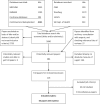Effect on caries of restricting sugars intake: systematic review to inform WHO guidelines
- PMID: 24323509
- PMCID: PMC3872848
- DOI: 10.1177/0022034513508954
Effect on caries of restricting sugars intake: systematic review to inform WHO guidelines
Abstract
A systematic review of studies in humans was conducted to update evidence on the association between the amount of sugars intake and dental caries and on the effect of restricting sugars intake to < 10% and < 5% energy (E) on caries to inform the updating of World Health Organization guidelines on sugars consumption. Data sources included MEDLINE, EMBASE, Cochrane Database, Cochrane Central Register of Controlled Trials, Latin American and Caribbean Health Sciences, China National Knowledge Infrastructure, Wanfang, and South African Department of Health. Eligible studies reported the absolute amount of sugars and dental caries, measured as prevalence, incidence, or severity. The review was conducted and reported in accordance with the PRISMA statement, and the evidence was assessed according to GRADE Working Group guidelines. From 5,990 papers identified, 55 studies were eligible - 3 intervention, 8 cohort, 20 population, and 24 cross-sectional. Data variability limited meta-analysis. Of the studies, 42 out of 50 of those in children and 5 out of 5 in adults reported at least one positive association between sugars and caries. There is evidence of moderate quality showing that caries is lower when free-sugars intake is < 10% E. With the < 5% E cut-off, a significant relationship was observed, but the evidence was judged to be of very low quality. The findings are relevant to minimizing caries risk throughout the life course.
Keywords: adult; carbohydrates; child; nutrition policy; oral health; sucrose.
Conflict of interest statement
The authors declare no potential conflicts of interest with respect to the authorship and/or publication of this article.
Comment in
-
"Effect on caries of restricting sugars intake: systematic review to inform WHO guidelines".J Dent Res. 2014 May;93(5):530. doi: 10.1177/0022034514526408. Epub 2014 Mar 4. J Dent Res. 2014. PMID: 24595636 No abstract available.
-
Response to letter to the editor, "Effect on caries of restricting sugars intake: systematic review to inform WHO guidelines".J Dent Res. 2014 May;93(5):531. doi: 10.1177/0022034514526409. Epub 2014 Mar 4. J Dent Res. 2014. PMID: 24595637 No abstract available.
-
Low intake of sugars may reduce risk of dental caries.J Evid Based Dent Pract. 2014 Jun;14(2):56-8. doi: 10.1016/j.jebdp.2014.04.018. Epub 2014 Apr 12. J Evid Based Dent Pract. 2014. PMID: 24913526 No abstract available.
-
Moderate evidence support a relationship between sugar intake and dental caries.Evid Based Dent. 2014 Dec;15(4):98-9. doi: 10.1038/sj.ebd.6401055. Evid Based Dent. 2014. PMID: 25522936
-
The Confluence of Sugar, Dental Caries, and Health Policy.J Dent Res. 2015 Oct;94(10):1338-40. doi: 10.1177/0022034515598958. Epub 2015 Aug 10. J Dent Res. 2015. PMID: 26261185 No abstract available.
References
-
- Akyüz S, Pince S, Garibagaoglu M. (1996). Nutrient intake and dental health in school children. J Marmara Univ Dent Fac 2:535-539 - PubMed
-
- Arnadottir IB, Rozier RG, Saemundsson SR, Sigurjons H, Holbrook WP. (1998). Approximal caries and sugar consumption in Icelandic teenagers. Community Dent Oral Epidemiol 26:115-121 - PubMed
-
- Battellino LJ, Cornejo LS, Dorronsoro de Cattoni ST, Luna Maldonado de Yankilevich ER, Calamari SE, Azcura AI, et al. (1997). Oral health status evaluation of pre-school children: longitudinal epidemiologic study (1993-1994), Cordoba, Argentina. Rev Saude Publica 31:272-281 [article in Spanish]. - PubMed
-
- Beighton D, Adamson A, Rugg-Gunn A. (1996). Associations between dietary intake, dental caries experience and salivary bacterial levels in 12-year-old English schoolchildren. Arch Oral Biol 41:271-280 - PubMed
-
- Birkhed D, Sundin B, Westin SI. (1989). Per capita consumption of sugar-containing products and dental caries in Sweden from 1960 to 1985. Community Dent Oral Epidemiol 17:41-43 - PubMed
Publication types
MeSH terms
Substances
LinkOut - more resources
Full Text Sources
Other Literature Sources
Medical


